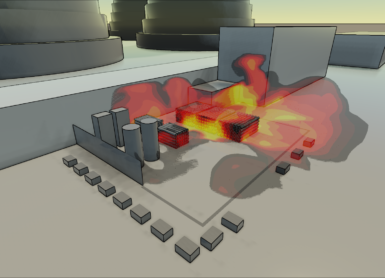
In a bid to fight the effects of climate change, focus has been placed on reducing emissions from within industrial, energy, transportation, and construction sectors to ensure that future objectives are achieved. Biogas is positioned to be a key part of a sustainable solution.
With the use of biogas and the number of production facilities increasing, the focus must be placed on facility siting and risk analysis as many of these sites are in close proximity to populated areas.
Using a CFD (Computational Fluid Dynamics) based risk analysis approach can enable operators to better understand facility risks and optimize land use planning.
Biogas, methane-rich gas produced from the breakdown of organic matter, is playing an increasingly important role in the energy transition. The gas has favourable environmental attributes and can be processed in a number of ways. Biogas can be upgraded to a quality similar to conventional natural gas, often called renewable natural gas (RNG), and distributed to consumers via the existing gas grid. It can also be liquefied, turned into liquefied biogas (LBG or bio-LNG), for use as fuel.
The interest in biogas and RNG is growing, and so is the number of facilities for production and distribution. As with all natural gas handling, these facilities are associated with potential hazards that must be understood and managed. Many facilities are located close to populated areas, which puts an even greater focus on proper facility siting and risk analysis.
Two key elements when analyzing facility risk are understanding how often an unwanted release can occur (release frequency), and how the release will spread in the environment (release consequence). Establishing sensible estimates for frequency and consequence can be challenging. For release frequency, there is a range of models to choose from. For release consequence, the physical behaviour of the release must be properly modelled. In particular, the behaviour of cryogenic liquids like LBG or LNG can be hard to capture.

Gexcon Consulting has recently assisted several biogas facilities in their risk analysis. An interesting case involved an LBG production facility located in hilly terrain and close to residential areas. To assess how cold and heavy gas from LBG releases would behave in this terrain a consequence analysis was performed using FLACS-CFD. The terrain turned out to have a strong impact on how gas was dispersed. The risk analysis showed that hills would shield certain areas from gas, while valleys would channel the gas onwards. After assessing the frequency and consequence for a wide range of scenarios, the nearby residential areas were found to be almost unaffected by the new facility.
At Gexcon, our Consulting team has experience with a wide range of studies involving biogas, natural gas, LBG, and LNG. Our X-suite software package offers a variety of tools to determine both the frequency and the consequence of hazardous scenarios. EFFECTS and Shell FRED offer an efficient way of modelling consequences for most release scenarios. FLACS-CFD will model consequences for release scenarios and show how consequence is affected by the surroundings.
Discover what Gexcon can do for you at our Products & Services page.
Do you like what you read?
Get the latest trends in the field of process safety management straight to your inbox, and enhance your skills through knowledge sharing from industry experts.


